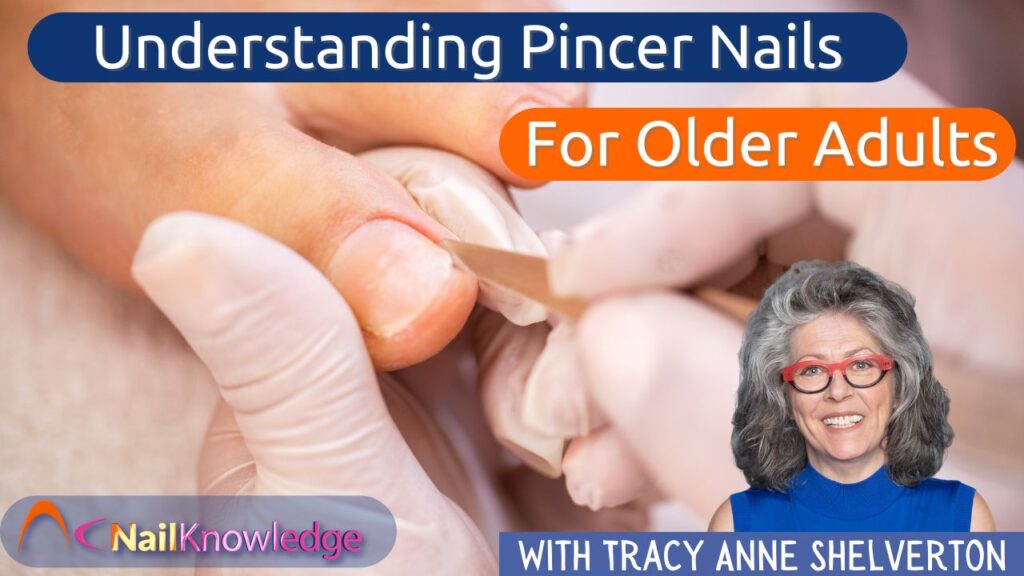Caring for older adults’ nails requires specialized knowledge, as age-related changes in nail and bone health can lead to unique challenges. One such issue is the development of “pincer nails,” a condition where nails curve sharply inward at the free edge, often causing discomfort or pain. This blog explores why this happens, how it affects older adults, and the best ways to manage it.
The Anatomy of Nails and Aging
Our nails are intricately connected to the bones underneath them, particularly the phalanges—the small bones that form the tips of our fingers and toes. As we age, these bones gradually break down, reducing the supporting base of the nail plate. This change impacts the nail matrix, the part of the nail that determines its shape and growth pattern.
With reduced bone support, the matrix adopts a tighter curvature, leading to the condition known as pincer nails. This process is natural and more common in older adults, but external factors, such as poorly fitted shoes, can exacerbate the problem.
The Impact of Ill-Fitting Shoes
For older adults, wearing comfortable, well-fitted footwear is crucial. Tight or improperly shaped shoes can compress the toes and thus the nail matrix, forcing nails to grow inward and become highly curved. When it comes to toes, in general the big toe nails, are the most affected.
For caregivers or podiatry professionals, it’s essential to encourage older clients to invest in footwear that provides adequate room for their toes. Proper footwear not only prevents the worsening of pincer nails but also enhances overall foot health.
Recognizing Pincer Nails in Older Adults
Pincer nails can vary in appearance based on their cause. In older adults, they often develop as a result of aging bones or external pressures like shoes. However, hereditary and acquired forms also exist.
• Hereditary Pincer Nails: These are symmetrical in shape, affecting both sides of the nail equally. They commonly appear in the great toe but can affect other nails as well.
• Acquired Pincer Nails: These are typically asymmetrical and can arise from medical conditions like psoriasis, cysts, tumors’, or fungal infections.
Podiatry professionals should look for signs of redness, warmth, or tenderness in the surrounding skin. These symptoms may indicate an underlying issue that requires medical attention.
When to Seek Medical Advice
Not all cases of pincer nails need medical intervention, but severe or painful conditions may warrant a podiatrist’s evaluation. For extreme cases, doctors may use surgical procedures to correct the nail’s curvature. However, there are conservative treatments available for less severe instances.
As a pedicure professional, it’s crucial to recognize your limits and refer clients to a qualified medical professional when necessary. Educating your clients about the importance of seeking timely medical advice can save them from prolonged discomfort.
Pedicure Tips for Managing Pincer Nails
Caring for pincer nails during a pedicure requires caution and expertise. Here are some tips for professionals working with older adults:
- Softening the Nails: Begin by soaking the feet in warm water to soften the nails, making them easier to trim.
- Careful Trimming: Use appropriate tools to trim the nails straight across, avoiding cutting too deep at the edges, which can worsen the condition.
- Gentle Filing: Smooth any sharp edges gently to reduce the risk of snagging or irritation.
- Avoid Excessive Pressure: Be mindful not to apply too much pressure to the nails, which can cause further discomfort.
- Foot Massage: End the cosmetic pedicure with a gentle foot massage to promote circulation and relaxation.
Educating Older Adults on Nail Care
Beyond providing pedicure services, educating older clients about proper nail care is invaluable. Here are a few tips to share:
• Regular Maintenance: Encourage clients to maintain regular nail trimming and care routines.
• Moisturizing the Feet: Dry skin contributes to nail issues; recommend twice daily moisturizing to keep the feet soft and healthy and the nail plate flexible.
• Routine Check-Ups: Suggest periodic visits to a podiatrist, especially for those with recurring nail problems.
• Proper Footwear: Remind clients to choose shoes that offer adequate space and support.
Supporting Older Adults Holistically
Dealing with pincer nails is more than a cosmetic concern—it’s about improving the quality of life for older adults. By understanding the underlying causes and providing thoughtful care, cosmetic pedicure professionals play a crucial role in managing this condition.
Always approach nail care for older adults with patience, empathy, and an awareness of their specific needs. When necessary, collaborate with medical professionals to ensure the best outcomes for your clients.
Conclusion
Pincer nails, though common in older adults, require specialized care and attention. By understanding their causes and implementing proper techniques, pedicure professionals can help alleviate discomfort and promote healthier nails. Remember, fostering open communication and offering practical advice and maintenance can make a significant difference in your clients’ overall well-being.


